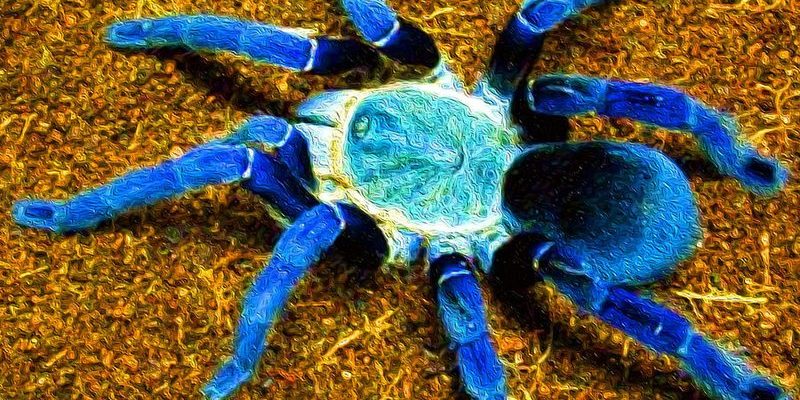
Tarantulas come in all shapes and sizes, each with their own unique quirks and personalities. Imagine a party where every guest has their own story to tell. The cobalt blue is like the enigmatic guest who captures everyone’s attention with their stunning looks but also sparks curiosity about their behavior and care needs. So, let’s dive into what makes the cobalt blue tarantula stand out in the world of these fascinating arachnids.
Physical Characteristics of the Cobalt Blue Tarantula
The cobalt blue tarantula is often celebrated for its striking appearance. Imagine a creature dressed in a royal blue outfit, shimmering under the light. This tarantula boasts a bold blue hue on its legs and carapace, while its abdomen can be a more subdued color. These vibrant colors are not just for show; they can indicate the spider’s health and age.
Unlike many other tarantulas, the cobalt blue has a compact body and long, slender legs. This unique physique allows it to be a fast and agile hunter. You might be wondering how this compares to other tarantulas. Well, while some species are stockier and slower, the cobalt blue is built for speed, which can make handling them a bit tricky—definitely something to consider if you’re thinking of keeping one as a pet.
Behavior and Temperament
When it comes to temperament, cobalt blue tarantulas are notorious for being skittish. Picture a cat that’s easily startled. This tarantula doesn’t enjoy being handled and prefers to stay in its burrow, often darting out only to hunt or defend its territory. If you’ve had other tarantulas, you might notice this behavior can contrast sharply with species that are more tolerant of handling.
On the flip side, their nervous disposition doesn’t detract from their fascinating behavior. Watching a cobalt blue tarantula hunt can be mesmerizing. They ambush their prey with incredible speed, showcasing their natural instincts. In contrast, some other tarantulas might rely on a more passive hunting style, waiting for food to come to them. Understanding these behavioral traits is essential, especially if you’re new to keeping tarantulas.
Habitat and Care Differences
Caring for a cobalt blue tarantula requires specific considerations. Native to Southeast Asia, they thrive in a humid environment that mimics their natural rainforest habitat. You’ll need to create a terrarium with ideal humidity levels and plenty of hiding spots. Think of it like setting up a cozy home for a shy friend—too much exposure isn’t ideal!
In comparison, other tarantula species like the Chilean Rose Tarantula can adapt to drier conditions. They might require less humidity and prefer a more open space. So, if you’re considering adding a tarantula to your collection, it’s crucial to research each species’ unique requirements. This way, you can provide the best home possible.
Feeding Habits
Feeding a cobalt blue tarantula is an art in itself. These spiders are carnivores and enjoy a diet of live insects, such as crickets and roaches. Watching them hunt can be incredibly rewarding as they capture their prey with lightning speed. Their feeding schedule usually consists of a few meals per week, depending on their age and size.
On the other hand, other tarantula species may have different preferences or feeding habits. For instance, some might be more forgiving with the types of insects they eat or require different feeding frequencies. For beginners, it’s worth noting that while the cobalt blue can be a bit more demanding in terms of food and environment, the experience of observing them can be well worth the effort.
Common Health Issues
Like any pet, cobalt blue tarantulas can face health issues, but they may be more prone to certain conditions due to their habitat needs. Overheating or inadequate humidity can lead to stress, making them more susceptible to diseases. It’s a bit like when we forget to hydrate on a hot day; we just don’t function as well!
In contrast, other tarantula types might have different health risks associated with their environments. For example, some may develop molting issues if they aren’t given enough space or suitable conditions. Keeping a close eye on your tarantula’s health can help you catch any problems before they become serious.
Breeding and Lifespan
If you’re curious about breeding, cobalt blue tarantulas have a unique reproductive cycle. They can live up to 10 years in captivity, with females generally outliving males. Their mating rituals can be intricate and somewhat risky for the male tarantula, adding an element of drama to their lifecycle.
Other species, like the Pink Toe Tarantula, may have different breeding habits and lifespans, often living longer due to their hardier nature. For any aspiring tarantula breeder, understanding the nuances of each species’ breeding habits is crucial to ensure successful and healthy offspring.
Cobalt blue tarantulas are truly captivating creatures, not just for their unique appearance but also for their fascinating behaviors and care needs. While they might be a bit more challenging to care for compared to other tarantulas, their vibrant presence can be incredibly rewarding. So, if you’re considering making one a part of your world, just remember that every tarantula is unique, and getting to know their personalities can make all the difference. Whether you have your heart set on the cobalt blue or another tarantula species, a little research and understanding can lead to a fulfilling experience with these remarkable arachnids.

